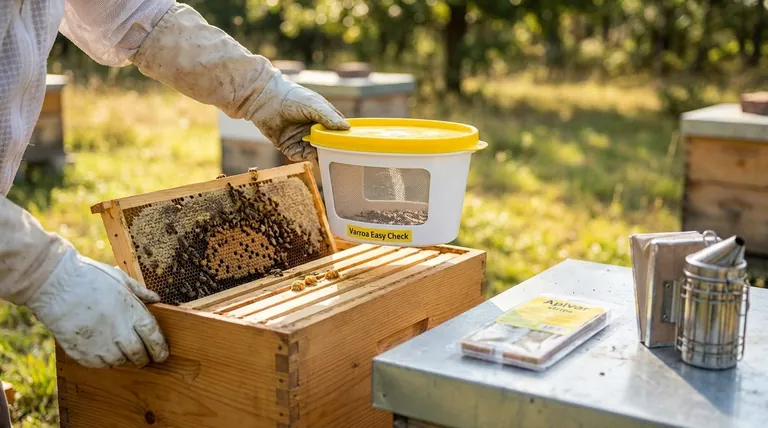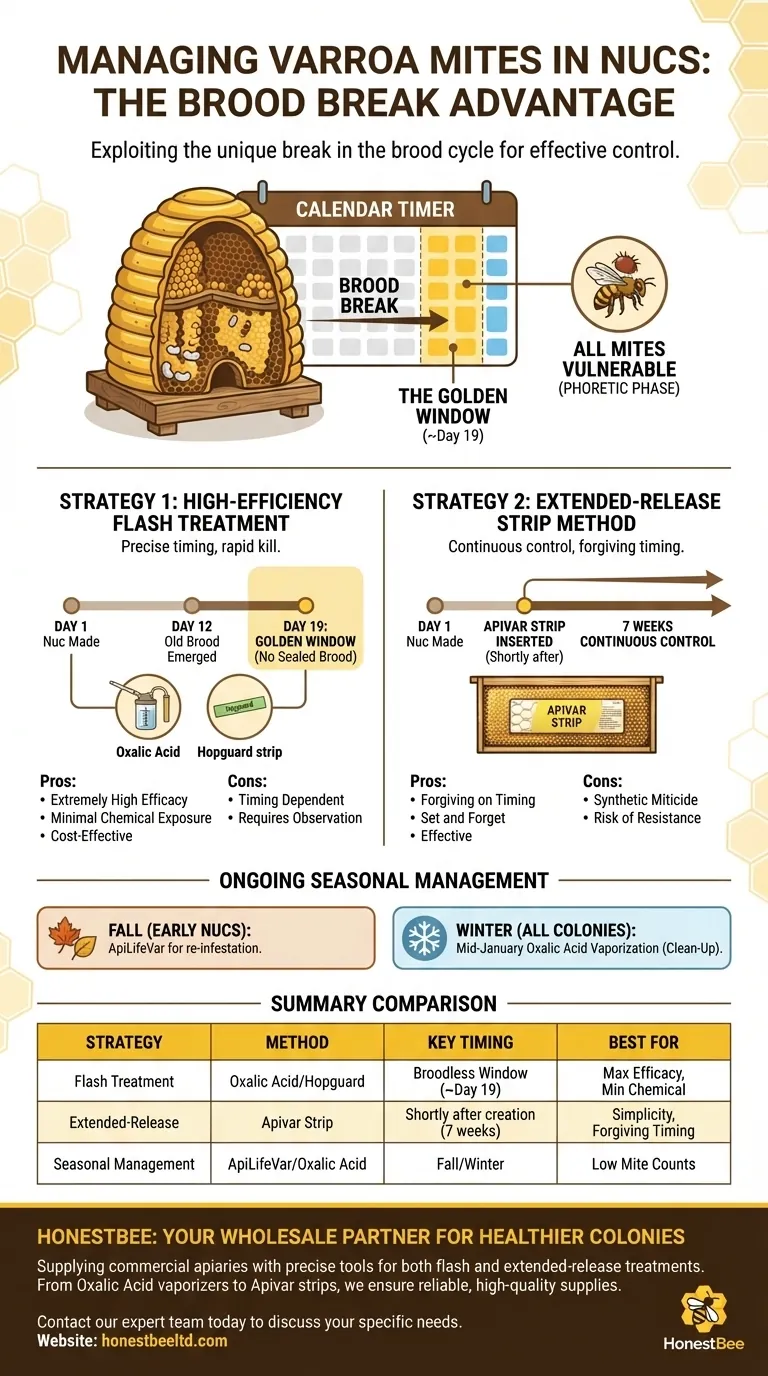Managing varroa mites in a nucleus colony (nuc) hinges on exploiting the unique break in the brood cycle that occurs after the nuc is created. The most effective methods involve either a precisely timed "flash" treatment like oxalic acid when no sealed brood is present, or the application of a slow-release miticide strip like Apivar to manage mites over a longer period. Both approaches are supplemented by routine late-season treatments.
The primary challenge of varroa management is that mites hide and reproduce in sealed brood cells. A newly made nuc offers a predictable window where no sealed brood exists, making nearly 100% of the mite population vulnerable and allowing for exceptionally effective treatment.

The Critical Advantage: The Nuc Brood Break
A newly created nuc provides a unique strategic advantage for controlling varroa mites that is not typically available in an established, continuously laying hive.
What is a Brood Break?
A brood break is a period when a colony has no sealed brood. In a new nuc started with a queen cell or a virgin queen, this happens naturally. The old brood from the parent hive will emerge, and there is a gap before the new queen mates, begins laying, and her new eggs are capped.
Why It Matters for Mite Control
Varroa mites have two life phases: the phoretic phase (on the bodies of adult bees) and the reproductive phase (inside sealed brood cells). Most treatments only kill phoretic mites. During a brood break, all mites are forced into the phoretic stage, exposing the entire mite population to treatment.
The "Golden Window" for Treatment
This ideal treatment window typically occurs for a very short time. It happens approximately 19 days after the nuc is made, a point where all the old brood has emerged, but the new queen's first batch of brood has not yet been sealed. This is often referred to as Day 30 in the overall nuc development cycle.
Strategy 1: The High-Efficiency Flash Treatment
This approach is centered on precise timing to achieve a rapid and highly effective mite kill.
The Principle: Capitalizing on the Broodless Period
By treating during the "golden window," you can eliminate the vast majority of mites in a single application. This dramatically reduces the mite load from the very beginning, giving the new colony a clean start.
Recommended Treatments
The most common treatments for this method are those that work quickly and are safe to use in a broodless colony. These include oxalic acid (in either dribble or vaporized form) or a short-duration organic strip like Hopguard.
Execution and Timing
The key is calculating the treatment day. If you create a nuc on Day 1, the old sealed brood will finish emerging by about Day 12. If the new queen starts laying around Day 14, her first eggs won't be sealed until around Day 23. The window for a highly effective broodless treatment is roughly between Day 12 and Day 22.
Strategy 2: The Extended-Release Strip Method
This is a simpler, more forgiving approach that does not rely on hitting a narrow window of time.
The Principle: Continuous Control
This method uses a miticide-impregnated strip that remains in the nuc for an extended period. It kills phoretic mites continuously and also kills mites that emerge with young bees from brood cells over several cycles.
Recommended Treatment
The standard for this approach is a single strip of Apivar (active ingredient: amitraz). It is placed in the nuc shortly after its creation.
Execution and Duration
The strip is left in the nuc for approximately seven weeks. This duration ensures it is active long enough to kill mites emerging from the initial batch of brood as well as mites from the new queen's first few brood cycles.
Understanding the Trade-offs
Neither strategy is universally superior; the best choice depends on your beekeeping style and goals.
Flash Treatment (e.g., Oxalic Acid)
- Pros: Extremely high efficacy when timed correctly. Minimal chemical exposure in the hive. Cost-effective.
- Cons: Entirely dependent on accurate timing. Missing the narrow broodless window significantly reduces its effectiveness. Requires careful observation or record-keeping.
Extended-Release (e.g., Apivar)
- Pros: Very forgiving on timing; a "set and forget" method. Effective even if you aren't sure of the exact brood status.
- Cons: Involves leaving a synthetic miticide in the hive for many weeks. Repeated use without rotation can contribute to mite resistance to the chemical.
Ongoing Seasonal Management
Initial treatment is not the final step. Mites will inevitably reappear through drift from other colonies.
Fall Treatments for Early Nucs
Nucs made early in the season may build their population—and their mite load—back up by fall. These may require an additional autumn treatment, such as ApiLifeVar, to ensure they go into winter with a low mite count.
The Standard Winter Clean-Up
Regardless of the initial method used, it is excellent practice to treat all colonies, including nucs, during the coldest part of winter. A mid-January oxalic acid vaporization is highly effective as the queen naturally stops or reduces laying in the cold, creating another broodless or low-brood period.
Making the Right Choice for Your Nuc
Your choice of strategy depends on your management priorities.
- If your primary focus is maximum efficacy and minimal chemical use: Plan for a precisely timed oxalic acid treatment during the natural brood break.
- If your primary focus is simplicity and forgiving timing: Use a single Apivar strip shortly after the nuc is established for continuous control.
- If you are managing any colony into the next year: Perform a final oxalic acid vaporization in mid-winter to eliminate residual mites before spring buildup.
Understanding the nuc's lifecycle transforms varroa control from a routine chore into a strategic opportunity for creating a healthier, more resilient colony.
Summary Table:
| Strategy | Method | Key Timing | Best For |
|---|---|---|---|
| Flash Treatment | Oxalic Acid or Hopguard | During broodless window (~19 days after nuc creation) | Maximum efficacy, minimal chemical use |
| Extended-Release | Apivar strip | Apply shortly after nuc creation, leave for 7 weeks | Simplicity, forgiving timing |
| Seasonal Management | ApiLifeVar (fall) or Oxalic Acid (winter) | Fall for early nucs, winter for all colonies | Ensuring low mite counts before winter/spring |
Ready to implement a winning varroa mite management strategy for your nucs?
HONESTBEE supplies commercial apiaries and beekeeping equipment distributors with the precise tools needed for both flash and extended-release treatment methods. From oxalic acid vaporizers to Apivar strips, our wholesale-focused operations ensure you get reliable, high-quality supplies to protect your colonies effectively.
Contact our expert team today to discuss your specific needs and build a healthier, more resilient beekeeping operation.
Visual Guide

Related Products
- Varroa Easy Check Mite Tester Kit Counter Alcohol Wash Jar
- Economy Galvanized Beekeeping Honey Bee Smoker for Wholesale
- Professional Bee Smoker with Elongated Spout and Durable Bellows for Beekeeping
- HONESTBEE Advanced Ergonomic Stainless Steel Hive Tool for Beekeeping
- Professional Insulated Winter Hive Wrap for Beekeeping
People Also Ask
- How is the infestation percentage calculated after counting mites? Master Varroa Mite Monitoring
- What are the steps to perform an alcohol wash test after collecting the bees? A Guide to Accurate Varroa Mite Counting
- What is the Varroa EasyCheck and its purpose? Streamline Your Hive Health Monitoring
- What are some popular methods to measure Varroa mite load in beehives? Compare Accuracy & Bee Safety
- How does the Varroa EasyCheck determine mite counts? Achieve Accurate Hive Health Monitoring



















